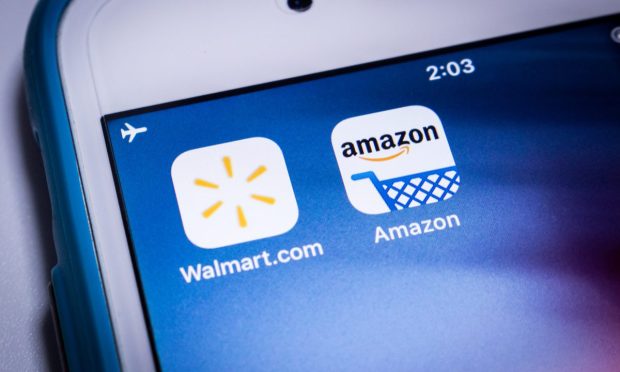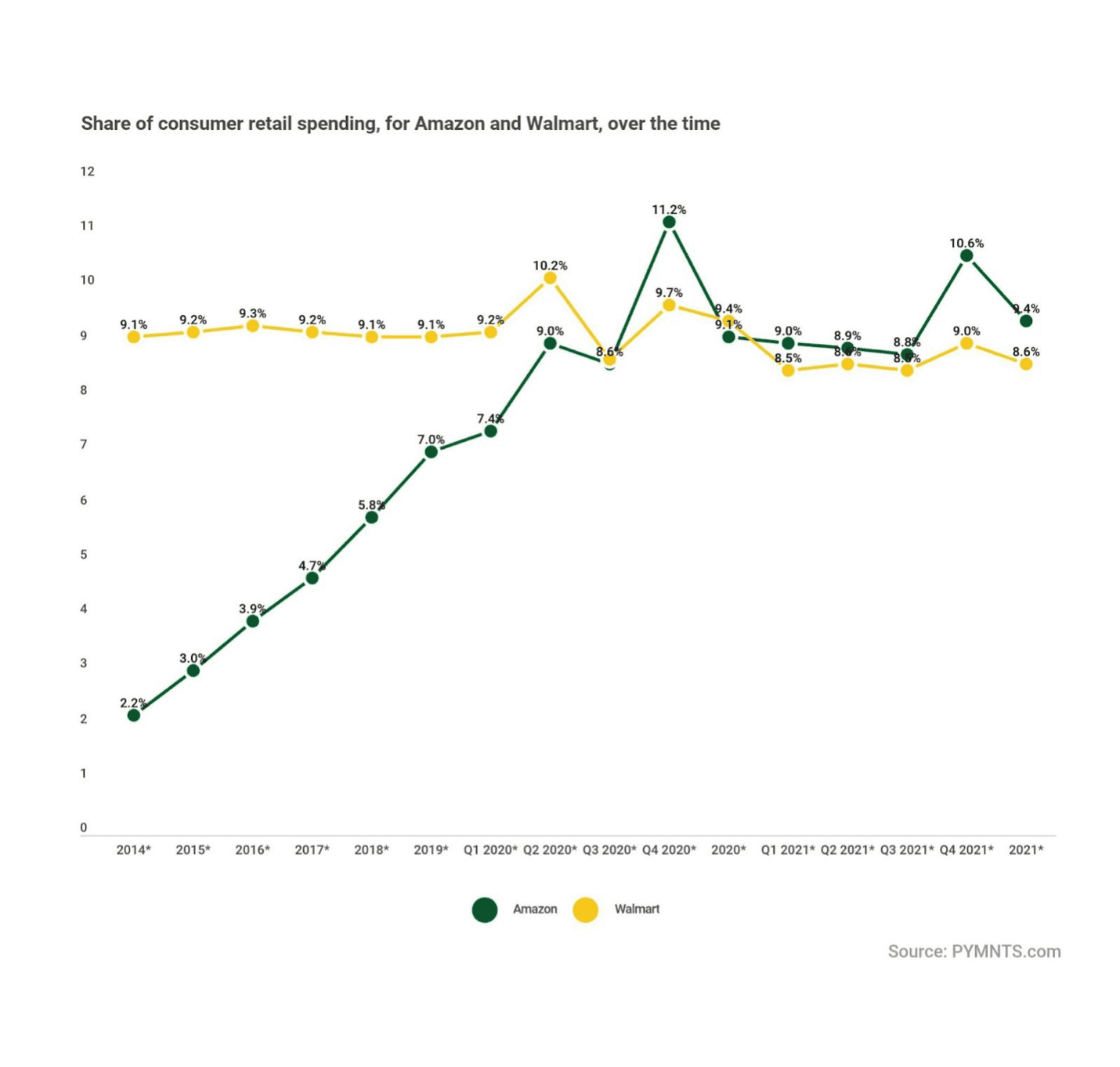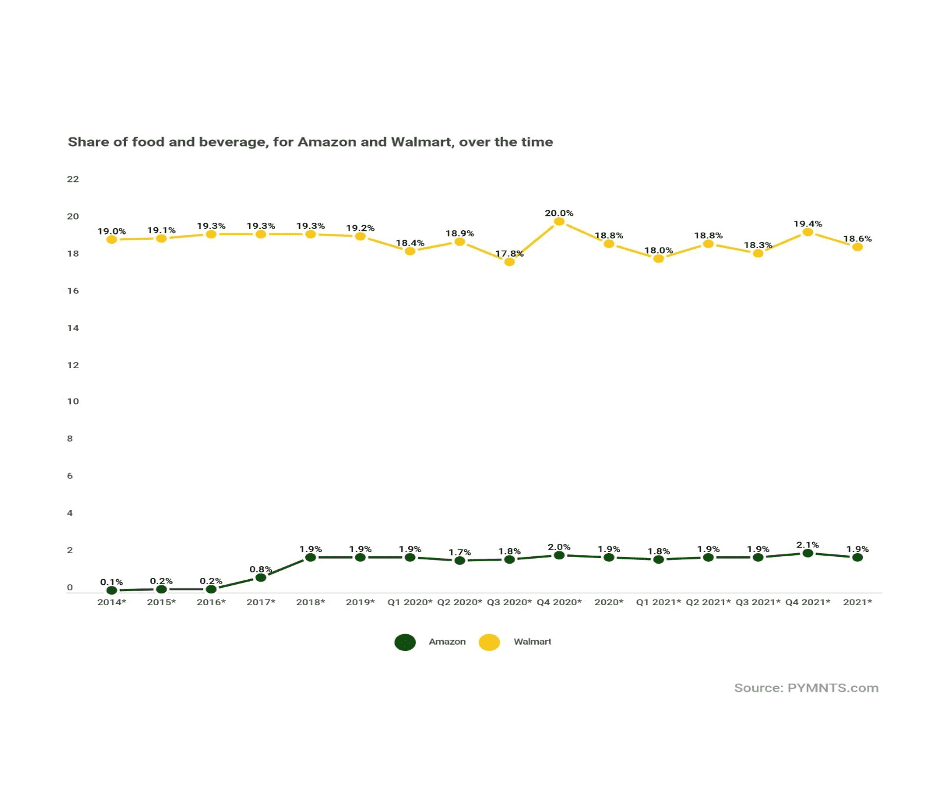AMZN vs WMT Weekly: Perennial Rivals Face Perpetual Change

For 10 years, Amazon has been steadily chipping away at Walmart’s lead in the battle to control the biggest slice of the American retail pie. While it moved into a statistical dead heat last year, this week it finally completed the long-anticipated change of leadership.
According to PYMNTS’ exclusive Whole Paycheck analysis, which includes both companies’ recently reported quarterly and full-year earnings results, the Seattle-based eCommerce leader finished 2021 with a comfortable 0.8% lead over its physical store rival, claiming a 9.4% share of U.S. retail spending compared to Walmart’s 8.6% portion.

The ongoing digital shift, fueled by two years of COVID lifestyle and consumption habit changes, combined with its big advantage in fourth-quarter sales, were enough to push Amazon into the top annual spot for the first in its history.
As the above chart shows, while Walmart has largely drifted sideways since 2014 with an approximate 9% share that used to be 4x bigger than Amazon’s stake, that gap has shrunk year after year and portended the leadership change which is now official.
For the record, PYMNTS’ sales figures strip out non-retail revenue generated from Amazon Web Services and instead calculate the gross merchandise value of items sold, including items sold for third parties where only a small percentage (typically 10%-15%) of those sales is calculated as revenue.
Instant Upheaval of War
While Amazon’s long-expected move into first place had an air of inevitability about it, the same cannot be said about the sudden outburst of war in the Ukraine and Russia’s unprovoked attack on a sovereign nation.
The ensuing atrocities, combined with an oil-led spike in inflation, have captivated and united the western world against a single foe in ways not seen in 75 years. While only two weeks into what many pundits project will likely be a long-running conflict, the instant economic upheaval caused by the record price of gasoline is already having a measurable impact.
For example, using the stock market as a barometer, shares of Walmart rose 5.6% in the first two weeks since the attack commenced on Feb. 24, while Amazon’s stock remained flat. The implied market message was that investors — and in time consumers — will flock to the more defensive low-price leader as concerns about inflation mount.
But even prior to the most recent outbreak of war, U.S. inflation had already been running at levels not seen since the 1970’s for the past few months. Over the past three months, Walmart’s stock has also been favored by investors, leaving its shares up 1%, compared to a 10% decline for the benchmark S&P 500 and a 19% slump for Amazon.
As an indicator, this performance discrepancy bodes watching as it implies Walmart is expected to do better during periods where household budgets are tight, and that value-seeking shoppers will flock to its stores in search of better deals — especially on food.
That is significant because PYMNTS latest sales data show Walmart holding steady with its category-leading 18.6% share of food and beverage sales compared to Amazon’s 1.9% slice that was unchanged in 2021.
Groceries are already Walmart’s single biggest category, accounting for $264 billion in sales last year or 56% of its gross revenue.
By comparison, According to PYMNTS research, Amazon’s food and beverage sales grew almost 13% last year, rising to $27.4 billion.

The Non-Food Battlegrounds
Although Amazon has recently announced it is focusing on groceries through its Whole Foods and Fresh locations while shuttering other non-grocery physical stores, the fight over food is not going to be won overnight against a rival with close to 5,000 domestic locations.
To that point, Amazon is looking to deepen its convenience quotient by expanding its same-day delivery service to more markets. The company announced this week that Prime members in the Salt Lake City area can now get $35+ orders of select items brought to their homes in 5 hours or less as part of the ongoing rollout and ramp of its Same Day Store.
For its part, Walmart is still busy adding capacity, logistical and pickup options to grow its digital and subscription businesses, it is also adding new in-store features aimed at driving foot traffic. For example, starting this summer, Walmart announced this week that it will begin deploying its U.K. cosmetic kiosk partnership with SpaceBeautyNK to 250 U.S. stores via extra-large merchandise islands that feature 600 products from 15 different makers that have been specially curated by the British beauty brand.
